An Erbium-Doped Fiber Source with Near-Gaussian-Shaped Spectrum Based on Double-Stage Energy Matching and LPFGs
Abstract
:1. Introduction
2. Principle of System
3. Experimental Results and Analysis
4. Conclusions
Author Contributions
Funding
Data Availability Statement
Conflicts of Interest
References
- Wysocki, P.F.; Digonnet, M.J.F.; Kim, B.Y.; Shaw, H.J. Characteristics of erbium-doped superfluorescent fiber sources for interferometric sensor applications. J. Light. Technol. 1994, 12, 550–567. [Google Scholar] [CrossRef]
- Li, Y.; Sun, Y.; Jiang, M. Influence of Er-doped superfluorescent fiber source’s spectrum-stability on the SNR of fiber optic gyroscopes. Optik 2014, 125, 3718–3721. [Google Scholar] [CrossRef]
- Swanson, E.A.; Izatt, J.A.; Lin, C.P.; Fujimoto, J.G.; Schuman, J.; Hee, M.R.; Huang, D.; Puliafito, C.A. In vivo retinal imaging by optical coherence tomography. Opt. Lett. 1993, 18, 1864–1866. [Google Scholar] [CrossRef]
- Lee, J.; Chung, Y.; DiGiovanni, D. Spectrum-sliced fiber amplifier light-source for multichannel WDM applications. IEEE Photon. Technol. Lett. 1993, 5, 1458–1461. [Google Scholar] [CrossRef]
- Moon, S.-R.; Yoo, S.-H.; Kye, M.; Lee, C.-H. Feed Forward Noise Suppression for ASE-Seeded WDM Systems. J. Light. Technol. 2016, 34, 2297–2303. [Google Scholar] [CrossRef]
- Zirngibl, M.; Doerr, C.; Stulz, L. Study of spectral slicing for local access applications. IEEE Photon. Technol. Lett. 1996, 8, 721–723. [Google Scholar] [CrossRef]
- Su, C.; Wang, L. Linewidth broadening of Er-doped superfluorescent fibre source using long-period grating. Electron. Lett. 1999, 35, 331–332. [Google Scholar] [CrossRef]
- Su, C.; Wang, L. Effect of adding a long period grating in a double-pass backward Er-doped superfluorescent fiber source. J. Light. Technol. 1999, 17, 1896–1903. [Google Scholar] [CrossRef]
- Espindola, R.; Ales, G.; Park, J.; Strasser, T. 80 nm spectrally flattened high power erbium amplified spontaneous emission fibre source. Electron. Lett. 2000, 36, 1263–1265. [Google Scholar] [CrossRef]
- Tian, J.J.; Yao, Y.; Sun, Y.X.; Xu, X.C.; Zhao, X.H.; Chen, D.Y. Flat Broadband Erbium Doped Fiber ASE Source Based on Symmetric Nonlinear Optical Loop Mirror. Laser Phys. 2010, 20, 1760–1766. [Google Scholar] [CrossRef]
- Zhang, J.; Sathi, Z.M.; Luo, Y.; Canning, J.; Peng, G.-D. Toward an ultra-broadband emission source based on the Bismuth and Erbium co-doped optical fiber and a single 830nm laser diode pump. Opt. Express 2013, 21, 7786–7792. [Google Scholar] [CrossRef]
- Jarabo, S.; Salgado-Remacha, F.J. Ultrawide broadband photonic source based on a new design of mode-locked erbium-doped fibre laser. Laser Phys. Lett. 2015, 12, 95104. [Google Scholar] [CrossRef]
- Tsai, S.; Lee, C.; Hsu, S.; Chen, Y. Characteristic comparison of single-pumped L-band erbium-doped fiber amplified spontaneous emission sources. Opt. Quantum Electron. 2002, 34, 1111–1117. [Google Scholar] [CrossRef]
- Tsai, S.-C.; Tsai, T.-C.; Law, P.-C.; Chen, Y.-K. High pumping-efficiency L-band erbium-doped fiber source using double-pass bidirectional-pumping configuration. IEEE Photon. Technol. Lett. 2003, 15, 197–199. [Google Scholar] [CrossRef]
- Zhu, L.; He, W.; Zhang, Y.; Luo, F.; Dong, M. A high flattening C + L band broadband source based on single pump and the same erbium-doped fiber. Optik 2014, 125, 4659–4662. [Google Scholar] [CrossRef]
- Patrick, H.; Kersey, A.; Burns, W.; Moeller, R. Erbium-doped superfluorescent fibre source with long period fibre grating wavelength stabilization. Electron. Lett. 1997, 33, 2061–2063. [Google Scholar] [CrossRef]
- Ou, P.; Cao, B.; Zhang, C.; Li, Y.; Yang, Y. Er-doped superfluorescent fibre source with enhanced mean-wavelength stability using chirped fibre grating. Electron. Lett. 2008, 44, 187–188. [Google Scholar] [CrossRef]
- Wang, A. High stability Er-doped superfluorescent fiber source improved by incorporating bandpass filter. IEEE Photon. Technol. Lett. 2011, 23, 227–229. [Google Scholar] [CrossRef]
- Wu, X.; Ruan, S.-C.; Liu, C.-X.; Zhang, L. High-stability erbium-doped photonic crystal fiber source. Appl. Opt. 2012, 51, 2277–2281. [Google Scholar] [CrossRef]
- Kikilich, N.; Aleinik, A.; Pogudin, G.; Vostrikov, E.; Smolovik, M.; Vinogradov, A.; Zalesskaia, I.; Motorin, E. Stabilization of the mean wavelength of an erbium-doped fiber source as part of high-accuracy FOG with increased spectrum width. Appl. Opt. 2022, 61, 6827–6833. [Google Scholar] [CrossRef]
- Ponosova, A.; Azanova, I.; Mironov, N.; Yashkov, M.; Riumkin, K.; Kel’, O.; Sharonova, Y.; Melkumov, M. Erbium-doped optical fibre with enhanced radiation resistance for superluminescent fibre sources. Quantum Electron. 2019, 49, 693–697. [Google Scholar] [CrossRef]
- Suo, X.; Yu, H.; Li, J.; Liu, Y.; Wu, X. Radiation-resistant flatness-shaped spectrum erbium-doped photonic crystal fiber source employing multiple self-compensating methods. Opt. Lett. 2020, 45, 5173–5176. [Google Scholar] [CrossRef] [PubMed]
- Guo, J.; Shi, R.; Wang, R.; Wang, Y.; Zhang, F.; Wang, C.; Chen, H.; Ma, C.; Wang, Z.; Ge, Y.; et al. Graphdiyne-Polymer Nanocomposite as a Broadband and Robust Saturable Absorber for Ultrafast Photonics. Laser Photonics Rev. 2020, 14, 1900367. [Google Scholar] [CrossRef]
- Magallón, D.A.; Jaimes-Reátegui, R.; García-López, J.H.; Huerta-Cuellar, G.; López-Mancilla, D.; Pisarchik, A.N. Control of Multistability in an Erbium-Doped Fiber Laser by an Artificial Neural Network: A Numerical Approach. Mathematics 2022, 10, 3140. [Google Scholar] [CrossRef]
- Sevilla-Escoboza, R.; Huerta-Cuéllar, G.; Jaimes-Reátegui, R.; García-López, J.H.; Medel-Ruiz, C.I.; Castañeda, C.E.; López-Mancilla, D.; Pisarchik, A.N. Pisarchik. Error-feedback control of multistability. J. Frankl. Inst. 2017, 354, 7346–7358. [Google Scholar] [CrossRef]
- Tan, S.; Li, Y.; Wang, X.; Jin, Z.; Zhang, H.; Jin, J. Parameters Optimization of ASE Source for the Improvement of Optical Power Stability in Space Radiation Environment. J. Light. Technol. 2022, 40, 2612–2618. [Google Scholar] [CrossRef]
- Kotov, L.; Ignat’Ev, A.D.; Bubnov, M.M.; E Likhachev, M. Effect of temperature on the active properties of erbium-doped optical fibres. Quantum Electron. 2016, 46, 271–276. [Google Scholar] [CrossRef]
- Liu, C.; Zhang, L.; Wu, X.; Ruan, S. Gamma radiation effects on erbium-doped fiber in superfluorescent fiber source. Opt. Fiber Technol. 2013, 19, 456–460. [Google Scholar] [CrossRef]
- Hall, D.; Burns, W.; Moeller, R. High-stability Er3+-doped superfluorescent fiber sources. J. Light. Technol. 1995, 13, 1452–1460. [Google Scholar] [CrossRef]
- Li, Y.; Jiang, M.; Zhang, C.X.; Xu, H.J. High stability Er-doped superfluorescent fiber source incorporating an Er-doped fiber filter and a Faraday rotator mirror. IEEE Photon. Technol. Lett. 2013, 25, 731–733. [Google Scholar] [CrossRef]
- Desurvire, E.; Simpson, J. Amplification of spontaneous emission in erbium-doped single-mode fibers. J. Light. Technol. 1989, 7, 835–845. [Google Scholar] [CrossRef]
- Vengsarkar, A.M.; Lemaire, P.J.; Judkins, J.B.; Bhatia, V.; Erdogan, T.; Sipe, J.E. Long-period fiber gratings as band-rejection filters. J. Light. Technol. 1996, 14, 58–65. [Google Scholar] [CrossRef]

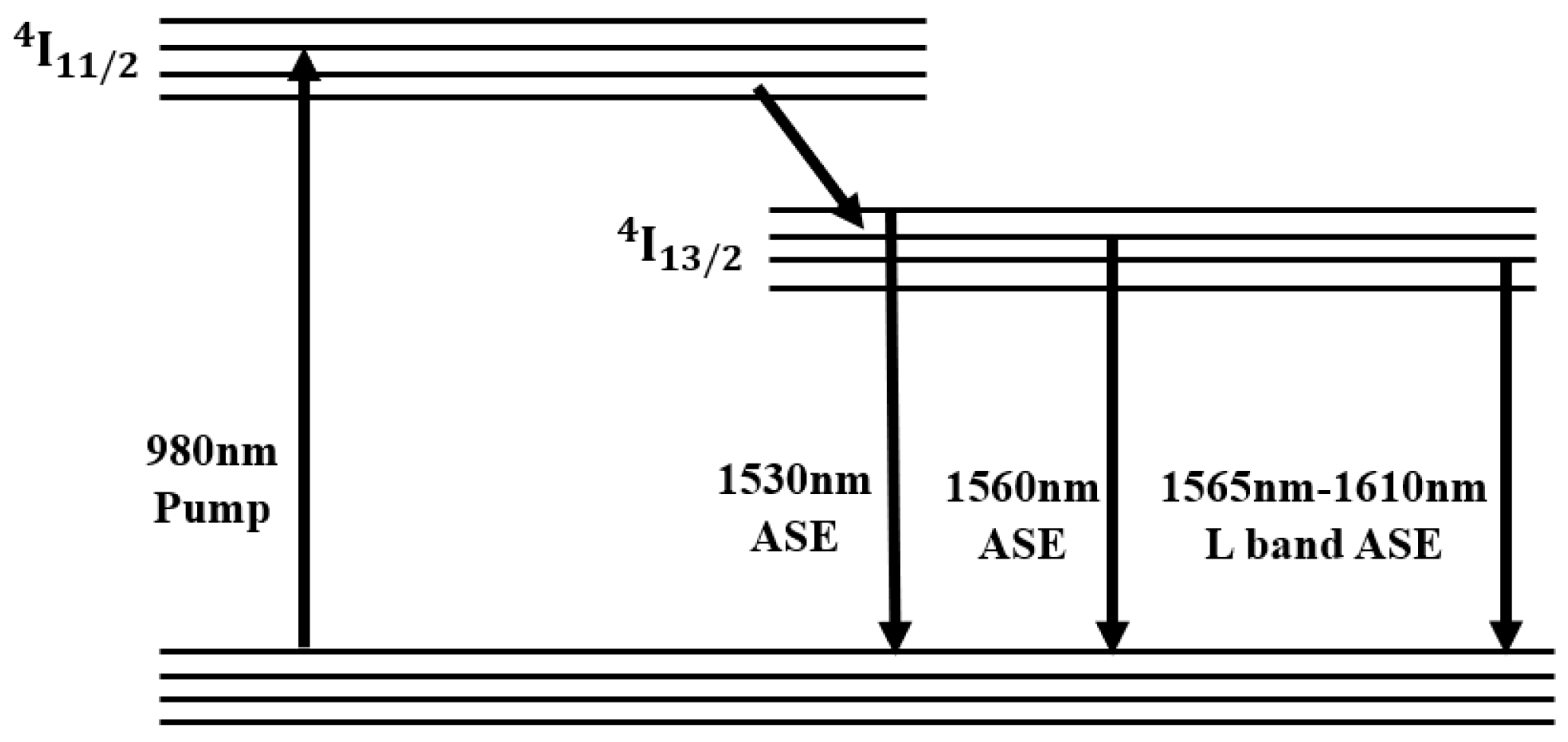
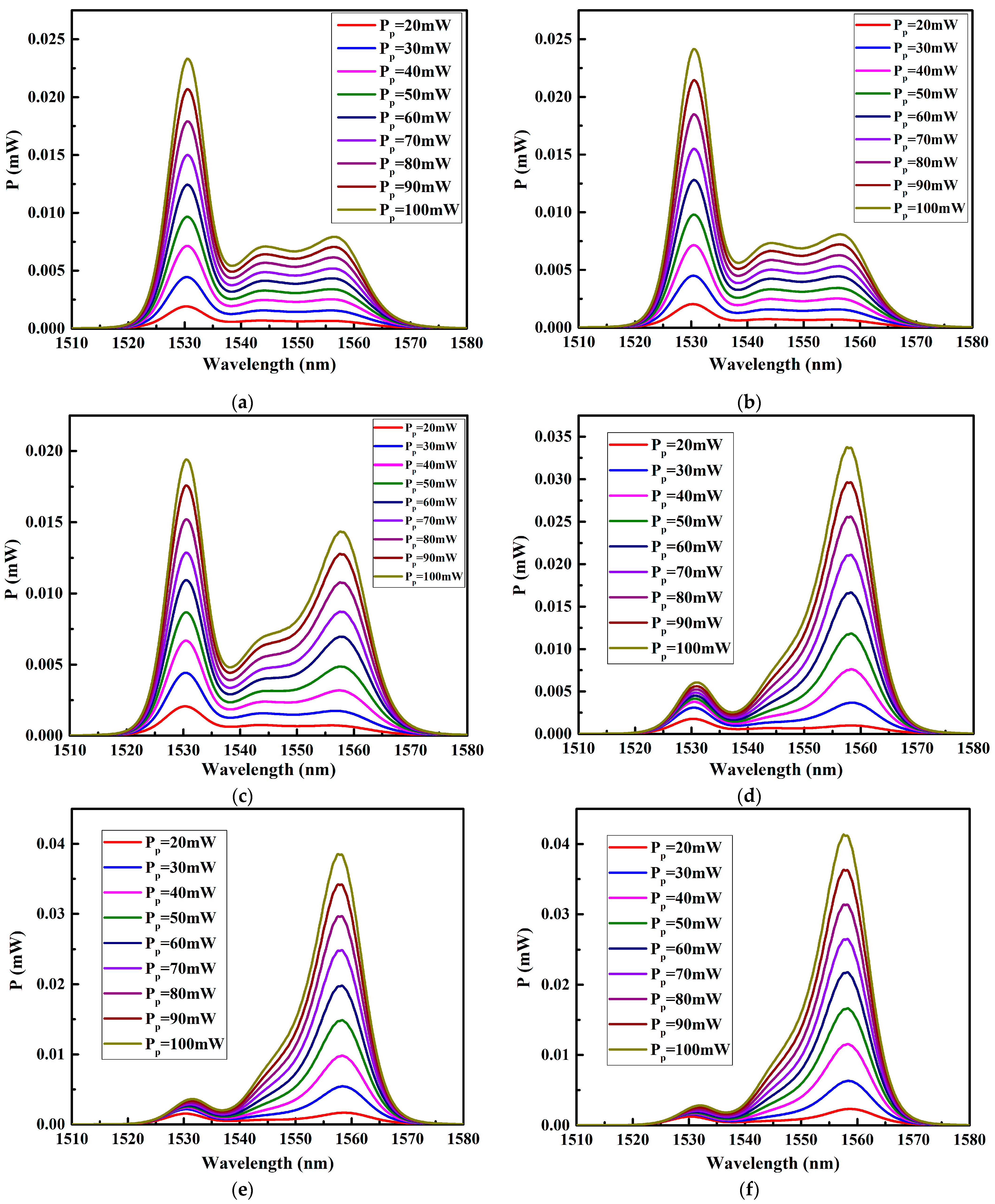



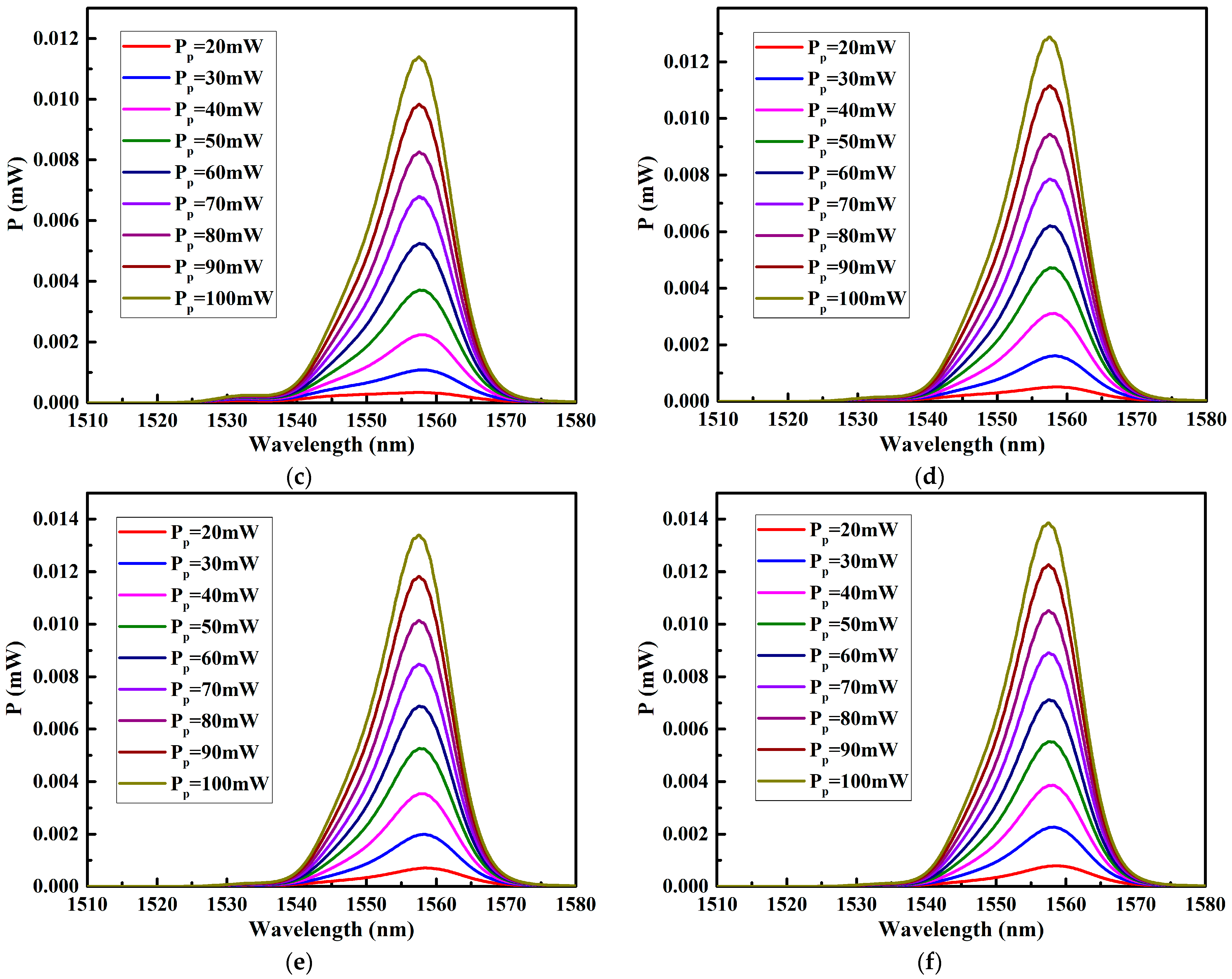
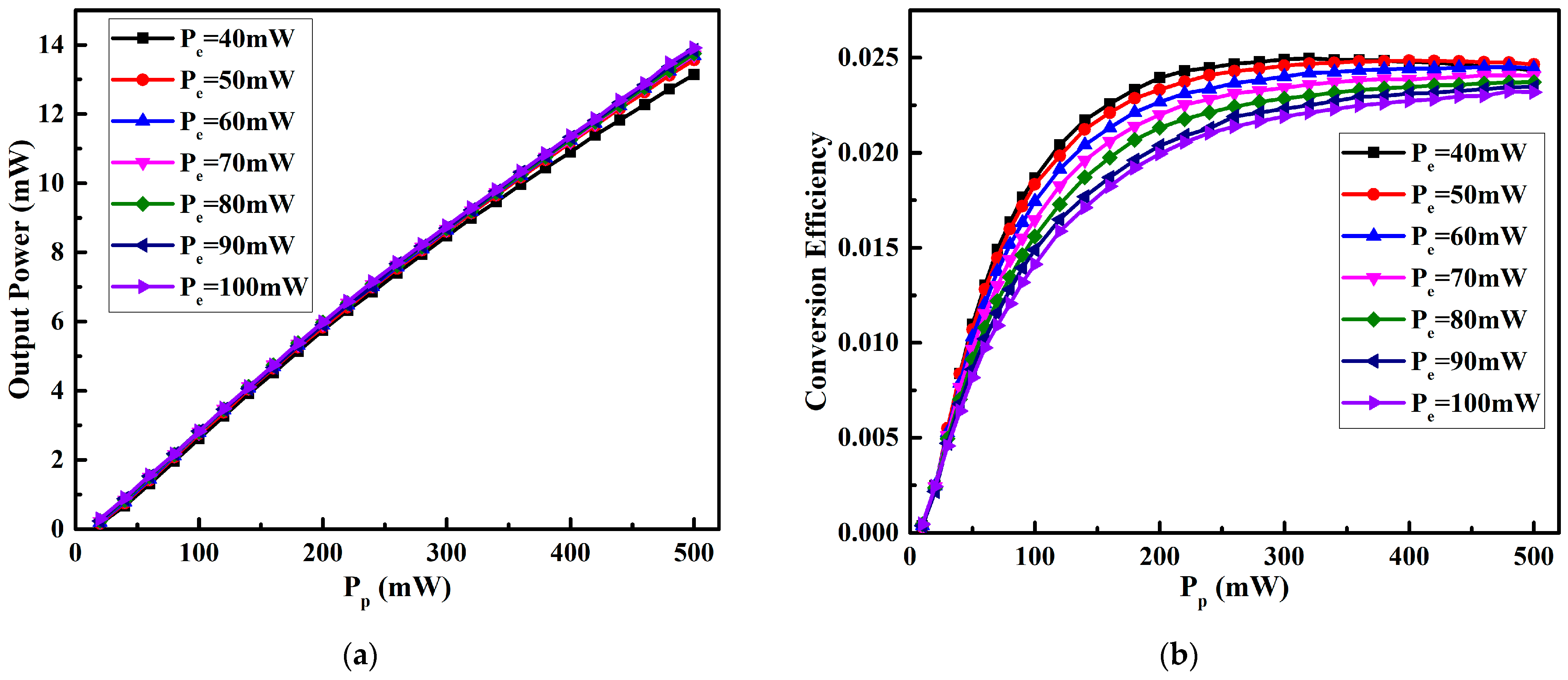
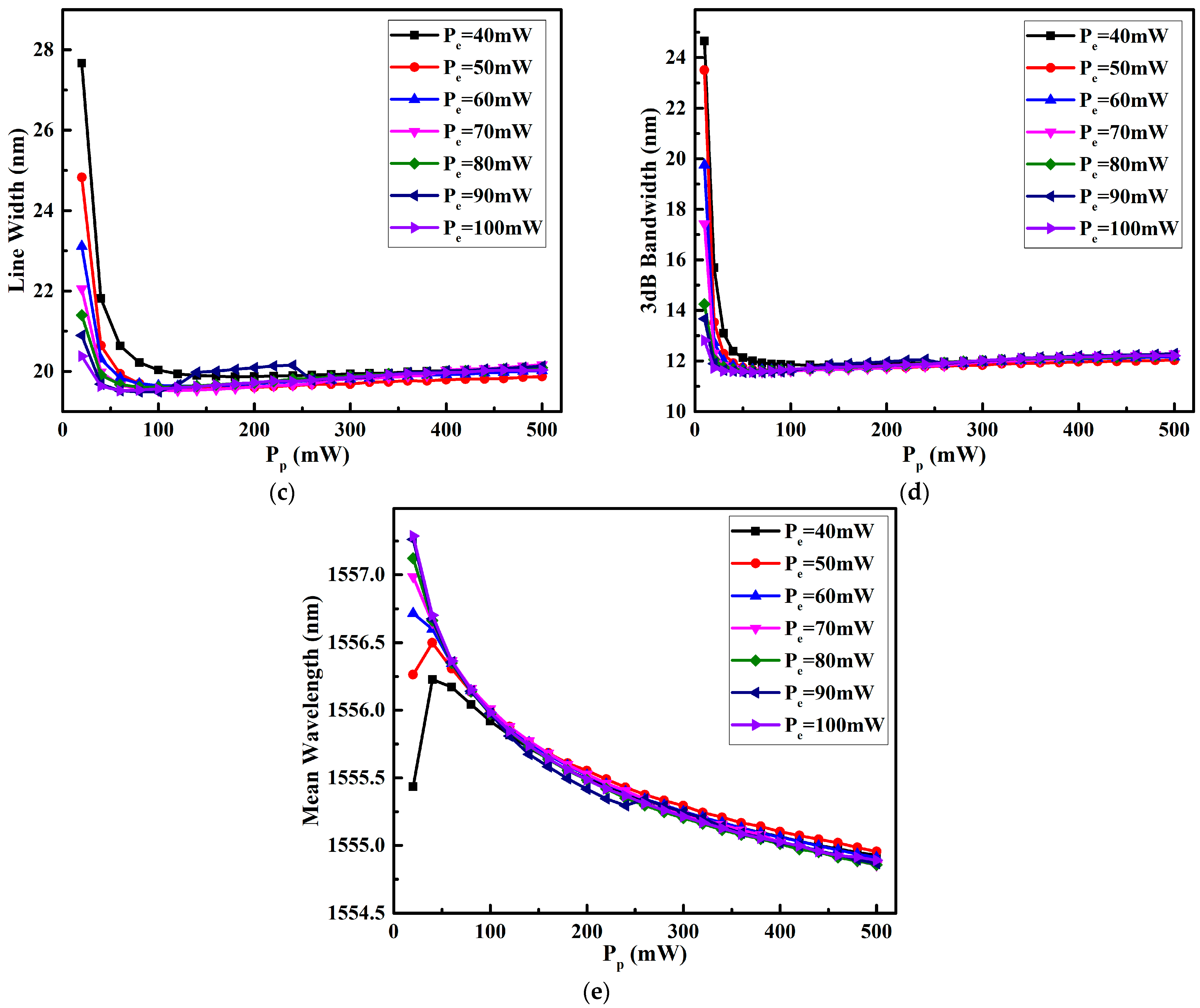
Disclaimer/Publisher’s Note: The statements, opinions and data contained in all publications are solely those of the individual author(s) and contributor(s) and not of MDPI and/or the editor(s). MDPI and/or the editor(s) disclaim responsibility for any injury to people or property resulting from any ideas, methods, instructions or products referred to in the content. |
© 2023 by the authors. Licensee MDPI, Basel, Switzerland. This article is an open access article distributed under the terms and conditions of the Creative Commons Attribution (CC BY) license (https://creativecommons.org/licenses/by/4.0/).
Share and Cite
Wan, S.; Zhan, T.; Hu, D.; Yan, H.; Han, D. An Erbium-Doped Fiber Source with Near-Gaussian-Shaped Spectrum Based on Double-Stage Energy Matching and LPFGs. Photonics 2023, 10, 533. https://doi.org/10.3390/photonics10050533
Wan S, Zhan T, Hu D, Yan H, Han D. An Erbium-Doped Fiber Source with Near-Gaussian-Shaped Spectrum Based on Double-Stage Energy Matching and LPFGs. Photonics. 2023; 10(5):533. https://doi.org/10.3390/photonics10050533
Chicago/Turabian StyleWan, Shiyong, Tiankui Zhan, Die Hu, Haitao Yan, and Daofu Han. 2023. "An Erbium-Doped Fiber Source with Near-Gaussian-Shaped Spectrum Based on Double-Stage Energy Matching and LPFGs" Photonics 10, no. 5: 533. https://doi.org/10.3390/photonics10050533




